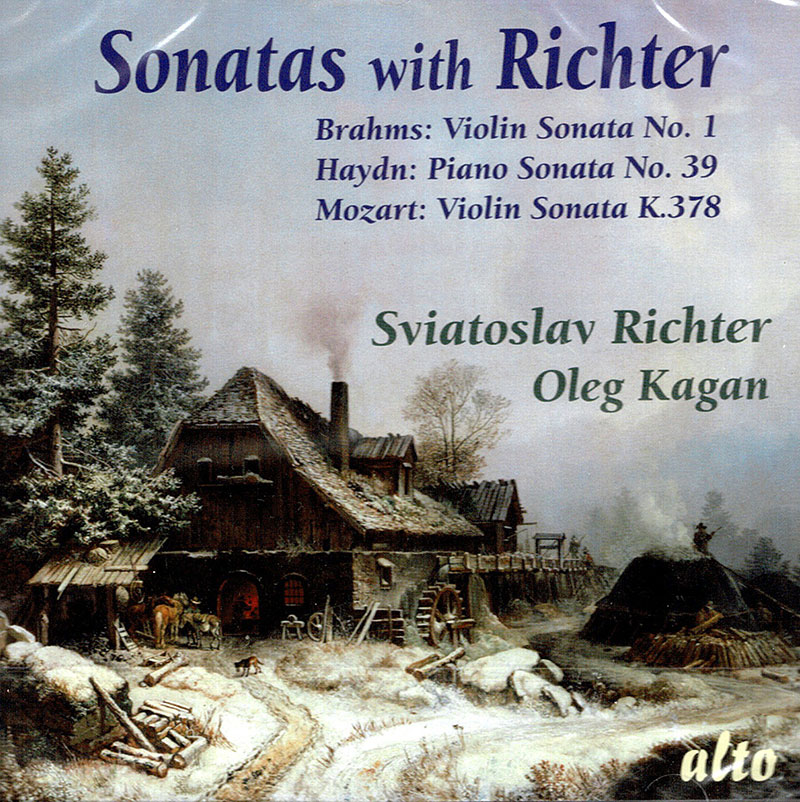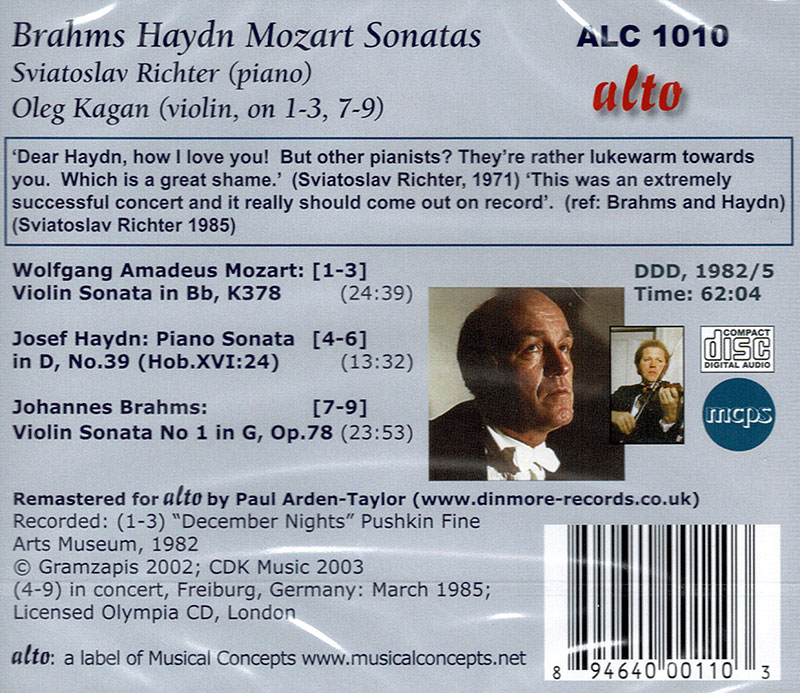Logowanie
Mikołaj - ten to ma gest!
Miles Davis, Horace Silver, Jay Jay Johnson, Percy Heath, Kenny Clarke, Lucky Thompson
Walkin'
20bit K2Super Coding - ale jak to brzmi!
Kasety magnetofonowe
Winylowy niezbędnik
ClearAudio
Double Matrix Professional - Sonic
najbardziej inteligentna i skuteczna pralka do płyt winylowych wszelkiego typu - całkowicie automatyczna
BRAHMS, HAYDN, MOZART, Sviatoslav Richter, Oleg Kagan
Sonatas

- Sviatoslav Richter - piano
- Oleg Kagan - violin
- BRAHMS
- HAYDN
- MOZART
The more time elapses since the death of great artists the more precious their memory and their recorded legacy becomes. That statement is particularly exemplified in relation to the two musicians represented on this record. Sviatoslav Richter (1915-1997), who gave his first public recital in Odessa at the age of 19, was a pupil of Heinrich Neuhaus at the Moscow Conservatory, and gained a huge reputation in the USSR. His status proceeded ahead of him to the West where a visit was eagerly awaited and where he finally played in 1960. Richter, however, was notoriously choosy, not only about the piano he played but the venues he played in, preferring small intimate halls rather than large ones. He decided against playing in the USA ever again after an extensive tour there in 1970. This only served to make his appearances more anticipated than ever and it was at places such as Aldeburgh and a few venues in France and Italy that had the privilege of welcoming him, always to huge acclaim. One could say that he was one of those rare people who became a legend in his own lifetime. He was a prodigious concert-giver on his own terms, however, and gave a staggering 91 concerts in 4 months during a massive tour by car from Leningrad to Vladivostok (about 9,000 miles!). Oleg Kagan (1946-1990) was born in Sakhalin but was brought up in Latvia until his family moved to Moscow where he was able to study with David Oistrakh. Kagan collected prizes with ease: the Enescu competition in Bucharest (1964), Sibelius, Helsinki (1965), Tchaikovsky, Moscow (1966) and Bach in Leipzig (1968). Kagan became a regular partner to Richter from 1969 who said of him that he had ‘a true understanding of Mozart’. The music represented here is supreme, and so are the performances. Both of these artists had an almost uncanny relationship that resulted in playing of the highest order. Richter himself, who could be very self-critical said of the Haydn and Brahms on this disc ‘This was an extremely successful concert and it really should come out on record’; we are lucky that someone took notice! An interesting, general comment Richter made about Haydn was ‘Dear Haydn, how I love you! But other pianists? They’re rather lukewarm towards you which is a great shame.’ (see: Sviatoslav Richter – Notebooks and Conversations by Bruno Monsaingeon, Faber 1998/2001). His love for Haydn certainly shows in his committed playing in the sonata on this record. Indeed this same sonata was played by Richter in public no less than 36 times and was one of 19 sonatas by Haydn that Richter programmed. It is largely due to him that these piano sonatas are back in fashion today. The publishers of Mozart’s violin sonatas urged in a magazine in April 1783 that both amateurs and professionals should try them for themselves. They were sure that this would prove that what they said about the sonatas was true, namely that they were rich in new ideas and showed the ‘great musical genius of their composer’ … with a ‘violin accompaniment that is so cleverly combined with the piano part that both instruments are continuously employed’. It seems such a shame that people in those days either had to be fortunate enough to play instruments themselves or to hear such works in performance in order to enjoy them. By contrast we are so incredibly lucky to have been born after the development of recording and so can enjoy them anywhere, anytime. The performance here of the Mozart sonata is superlative in its beauty with the two artists creating a feeling of being totally at one with each other; the second movement is a perfect example of this and is extremely moving. At the end of the work, which was recorded live, there is a cry of delight from one audience member and no wonder! Brahms composed his violin sonata No.1 with his great friend, the violinist Joseph Joachim in mind. The liner-notes indicate that Richter first played this sonata in February 1985 whilst this recording is from March the same year during the final series of concerts that he and Kagan gave; Kagan died prematurely aged only 44 in 1990 while organizing a festival in Germany. If the implication is that Richter had only recently learned the work when this recording was made it is all the more remarkable for it sounds for all the world as if he had always been playing it, such is the richness in the playing of both artists. This is a disc to cherish, particularly since the sterling work done by Paul Arden-Taylor in remastering the original has made it feel as fresh as if it had been recorded yesterday. Steve Arloff































